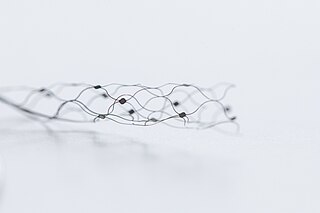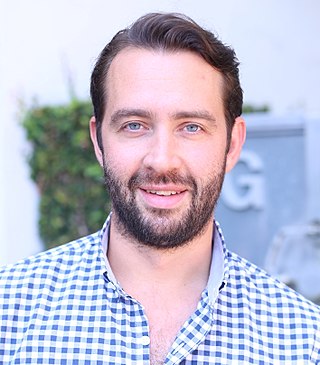
A brain–computer interface (BCI), sometimes called a brain–machine interface (BMI), is a direct communication link between the brain's electrical activity and an external device, most commonly a computer or robotic limb. BCIs are often directed at researching, mapping, assisting, augmenting, or repairing human cognitive or sensory-motor functions. They are often conceptualized as a human–machine interface that skips the intermediary of moving body parts (hands...), although they also raise the possibility of erasing the distinction between brain and machine. BCI implementations range from non-invasive and partially invasive to invasive, based on how physically close electrodes are to brain tissue.
Neurotechnology encompasses any method or electronic device which interfaces with the nervous system to monitor or modulate neural activity.

The Charité – Universitätsmedizin Berlin is Europe's largest university hospital, affiliated with Humboldt University and the Free University of Berlin.
Neuroergonomics is the application of neuroscience to ergonomics. Traditional ergonomic studies rely predominantly on psychological explanations to address human factors issues such as: work performance, operational safety, and workplace-related risks. Neuroergonomics, in contrast, addresses the biological substrates of ergonomic concerns, with an emphasis on the role of the human nervous system.
The BCI Research Award is an annual award for innovative research in the field of brain-computer interfaces. It is organized by the BCI Award Foundation. The prize is $3000 for first, $2000 for second, and $1000 for third place. The prizes are provided by g.tec medical engineering, Cortec, Intheon and IEEE Brain.. Christoph Guger and Dean Krusienski are the chairmen of the Foundation.

The Center for Neurotechnology (CNT) is an Engineering Research Center funded by the National Science Foundation, develops devices to restore the body's capabilities for sensation and movement. The center is based at the University of Washington. Its core partner organizations are the Massachusetts Institute of Technology and San Diego State University.
The Bernstein Network is a research network in the field of computational neuroscience; this field brings together experimental approaches in neurobiology with theoretical models and computer simulations. It unites different scientific disciplines, such as physics, biology, mathematics, medical science, psychology, computer science, engineering and philosophy in the endeavor to understand how the brain functions. The close combination of neurobiological experiments with theoretical models and computer simulations allows scientists of the Bernstein Network to pursue innovative approaches with regard to one of the most complex structures nature has created in the course of evolution: the natural brain.

Stentrode is a small stent-mounted electrode array permanently implanted into a blood vessel in the brain, without the need for open brain surgery. It is in clinical trials as a brain–computer interface (BCI) for people with paralyzed or missing limbs, who will use their neural signals or thoughts to control external devices, which currently include computer operating systems. The device may ultimately be used to control powered exoskeletons, robotic prosthesis, computers or other devices.

Detlev Ganten is a specialist in pharmacology and molecular medicine and is one of the leading scientists in the field of hypertension. He founded the World Health Summit in 2009. He was Chairman of the Foundation Board of the Charité Foundation (2005–2015), editor of the Journal of Molecular Medicine, Chairman of the Board of Trustees of the Max Planck Institute of Colloids and Interfaces and Max Planck Institute of Molecular Plant Physiology as well as Chairman of the Board of Trustees of the Ethnological Museum Dahlem of the Prussian Cultural Heritage Foundation.
Clinatec is a biomedical research center based at the Polygone Scientifique in Grenoble. Doctors, biologists and micro- and nanotechnology experts work side by side at the 6,000 m2 facility. Around a hundred researchers and employees work at the center. When it opened at the end of 2011, it was hailed as the first center of its kind in the world. With six hospital rooms, cutting-edge medical imaging equipment and an operating suite, Clinatec was developed by the Research Division of the CEA, Grenoble-Alpes University Hospital (CHU), Inserm and the Université Grenoble Alpes. The primary focus is on cancer, neurodegenerative diseases and disability.

Minoo Lenarz, born Minoo Moshrefi, was an Iranian-German Professor and medical scientist.
The Werner Reichardt Centre for Integrative Neuroscience (CIN) is the common platform for systems neuroscience at the University of Tübingen in Germany. It was installed as a cluster of excellence within the framework of the Excellence Initiative in 2007/2008. About 90 scientists with their research groups – 21 of which are supported with excellence initiative funds – form the CIN's membership. The focus of their work is on basic research in systems neurobiology. Based on an interdisciplinary and integrative approach, it encompasses projects rooted in biology, medicine, physics, computer science and engineering, as well as cognition and neurophilosophy.

Christian T. Wentz is an American electrical engineer and entrepreneur. He is recognized for his work in engineering authenticity in electronic devices and the use of these primitives in distributed systems, developing neural interface technologies and innovation in optoelectronics, low power circuit design, wireless power and high bandwidth communication technologies.
Neural dust is a hypothetical class of nanometer-sized devices operated as wirelessly powered nerve sensors; it is a type of brain–computer interface. The sensors may be used to study, monitor, or control the nerves and muscles and to remotely monitor neural activity. In practice, a medical treatment could introduce thousands of neural dust devices into human brains. The term is derived from "smart dust", as the sensors used as neural dust may also be defined by this concept.
Georg Winterer is a German entrepreneur, neuroscientist and specialist in psychiatry and psychotherapy. He is an Associate Professor at the Charité – University Medicine Berlin, director of the Neuroimaging Research Group in the Experimental and Clinical Research Center (ECRC) at the Charité – University Medicine Berlin. He is the founder and managing director of the Berlin PI Solutions Group GmbH.

Friedhelm Christoph Hummel is a German neuroscientist and neurologist. A full professor at École Polytechnique Fédérale de Lausanne, he is the Defitech Chair of Clinical Neuroengineering, and the head of the Hummel Laboratory at EPFL's School of Life Sciences. He also is an associate professor of clinical neuroscience at the University of Geneva.

Thorsten O. Zander is a German scientist who introduced the concept of passive brain-computer interface. He co-founded Zander Labs, a German-Dutch company in the field of passive brain computer interface (pBCI) and neuro-adaptive technology (NAT).
The Einstein Foundation Berlin is a foundation based in Berlin, Germany "that aims to promote science and research of top international caliber in Berlin and to establish the city as a centre of scientific excellence." It does this through various objectives, including the cross-institutional promotion of Berlin research projects, the appointment of outstanding scientists to Berlin, targeted support for young researchers, and better cooperation between university, non-university, and private sector institutions.

Lead-DBS is an open-source toolbox for reconstructions and modeling of Deep Brain Stimulation electrodes based on pre- and postoperative MRI & CT imaging.

Stephan Sigrist is a German geneticist, neurobiologist, and biochemist. He is a professor of genetics at the Department of Biology, Chemistry, and Pharmacy at the Free University of Berlin.











